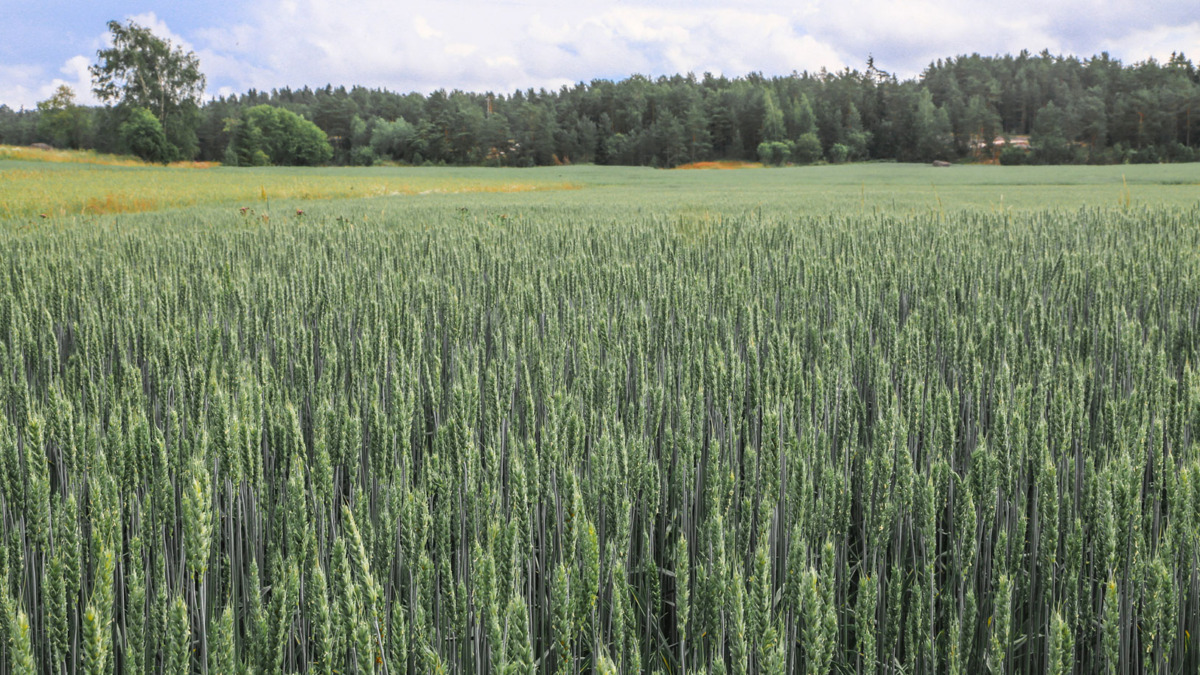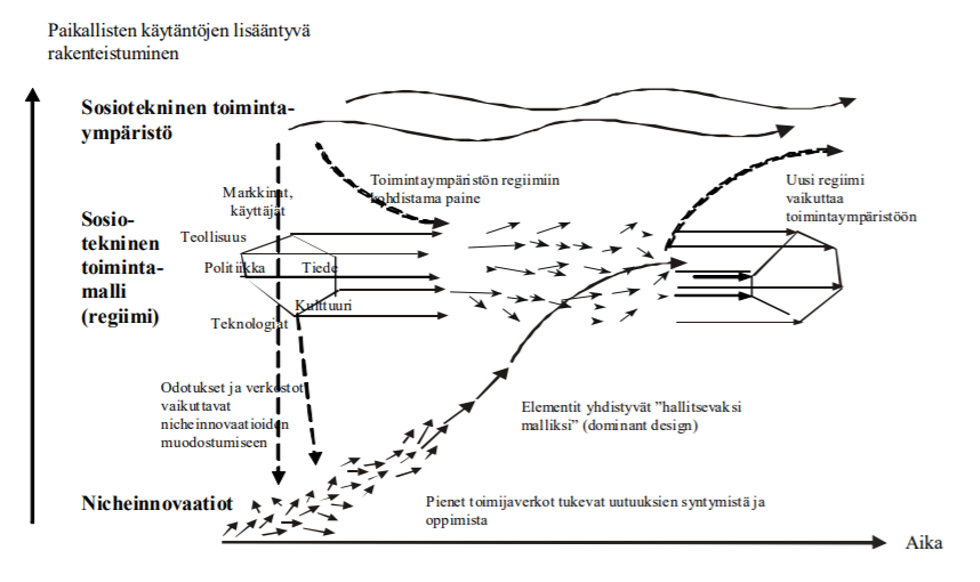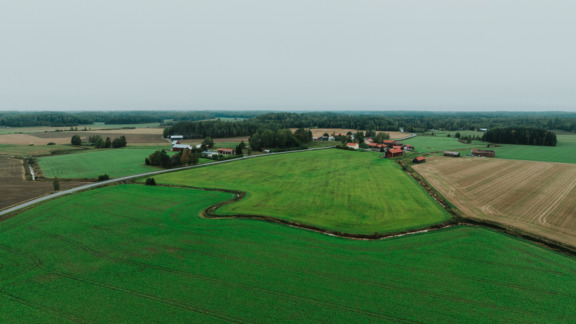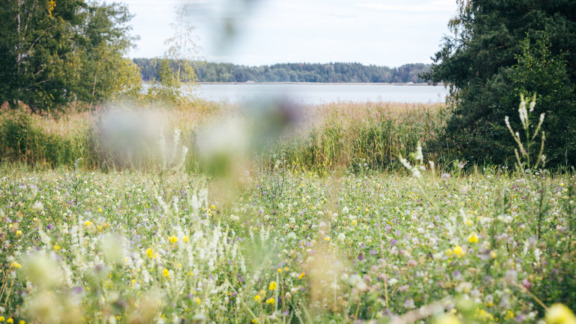Blog: Systemic change – what does it mean? Carbon Action as an example
Three years ago, I wrote a blog about systemic change and Carbon Action. A lot has happened since then, and it’s a good time to update this blog. In Carbon Action, we are actively promoting regenerative agriculture. Many national and international actors are eagerly participating in the work. The main challenges lie in agricultural policy.

The major goal of the Carbon Action platform is a systemic change toward regenerative agriculture. This change also plays a central part in the efforts to achieve a carbon-neutral society and a sustainable food system. We have made very good progress in Carbon Action – relying heavily on research and working closely with key stakeholders (Höijer 2023).
Systemic change is not an easy-to-understand concept. A picture helps (Figure 1). The model by Geels and Schot highlights that systemic change is a challenge of such magnitude, that we must go about it one step (or project) at a time. At the same time, we have to keep the big picture in mind and stay on the right path toward our goal.

Figure 1. A multi-level perspective on socio-technical transitions. According to the model, the interaction between the landscape, regime, and niche innovations allows for system change. The incompatibility of the landscape and regime acts as a “driver” that creates pressure for regime reform and the breakthrough of new innovations at the regime level (original Geels & Schot 2007 & modified by Valovirta et al. 2011).
Applying the model to Carbon Action work
With the help of Valovirta’s excellent report (Valovirta et al. 2011), I applied the model to Carbon Action work. The model consists of three dimensions:
- Dimension: regime is a set of policies, interpretative frameworks, and problem-solving models that are considered self-evident. The regime can be divided into five dimensions: user and market, technological, science, policy and socio-cultural. In the Carbon Action model, the regime consists of agriculture in the broadest sense – the goal being a shift from the conventional agricultural model to a regenerative model.
- Dimension: landscape that includes a wide range of societal developments. The regime’s operating models are not necessarily compatible with the changing landscape. Landscape may thus affect the regime in a way that opens a “window of opportunity” for efforts to reform the regime or even form an entirely new regime. Big ecological drivers for change (VNK 2019) in Carbon Action are, climate change, the state of the environment and nature, and the sustainability of natural resource use.
- Dimension: the development of new models of operating outside the current regime. As these new models strengthen and merge with other parallel reform efforts, they may form a “dominant model” that can change the prevailing regime as the “window of opportunity” opens. In the Carbon Action model, this includes the projects and activities of the Carbon Action platform. BSAG coordinates the platform – to ensure we stay on the right path.
It is also good to note that the regime is constantly “dynamically stable” (Nieminen et al. 2011). Even within the regime, in this case in conventional agriculture, constant renewal is present. However, renewal within the regime does not necessarily change the patterns, values, and beliefs that make up the regime, but rather adapt it to the ever-changing landscape. The regime may then also assimilate new insights and practices from the outside, but the changes will take place within the framework defined by the prevailing regime. My interpretation is, that at the moment, we are at that stage.
Nationally and internationally, there is a lot of ongoing activities promoting regenerative agriculture, which bring renewal to the prevailing regime.
Laura Höijer
At some point, however, the operation of the regime and the changes in the landscape may come to a broader state of incompatibility, bringing the whole regime into crisis. This opens up a “window of opportunity” for the development of a new regime. We can already see some incompatibility. In the blog I wrote three years ago, I set the goal that change has been achieved by 2035 in Finland – which is the year that Finland aims to become carbon neutral (Figure 2).

FIGURE 2. Carbon Action interpreted through a model of socio-technical change (adapted from Geels & Schot 2007)
Interaction and co-creation between actors inside and outside the regime
To be able to comprehend what the change means, all three levels need to be taken into account (Nieminen et al. 2011). The aim is that small changes in the system lead to large-scale changes at the system level over a longer period. What is essential is to enable interaction, communication, and mutual learning between stakeholders inside and outside the regime. The more stakeholders are involved and committed, the more defined the path towards change becomes. This is the strength of the work carried out on the Carbon Action platform. Stakeholders on the platform – farmers, advisors, researchers, companies, and decision-makers – learn together and co-create.
The path of change must be based on research data. An example of the research done in Carbon Action is the development of a scientifically ambitious measurement and verification system. The system can help us determine the amount of carbon stored in the soil. The verification of changes in the carbon stocks makes it possible for farmers to monitor how these cultivation methods affect the soil. Companies in the food supply chain are interested in the carbon footprint of production. On a societal level, scientific verification provides a basis for agricultural and climate policy instruments and a possible carbon credit market.
Scaling the activities in practice
It’s important to make sure that the steps taken are effective enough – so that we are able to scale up the actions. Bottlenecks also need to be identified and addressed. On the Carbon Action platform, we identified that training of skillful advisors had become a bottleneck in our work. Therefore, together with other key actors, we trained new advisors. This work continues.
It is essential that the produced knowledge is used and that new farmers are involved. In order to share the knowledge and practical experience gained in Carbon Action with all interested farmers and other agricultural experts, the Carbon Action club was established in 2020. Knowledge is also continuously disseminated through the free ‘E-college for Regenerative Farming’ (UVO). UVO has about 2,200 registered participants. A short version of UVO, targeted especially at decision-makers, company representatives, and consumers will be published in 2024.
Involving young people is essential when we want change. We cooperate with agricultural schools so that we can also reach future farmers. Youth representatives have been involved in the work, for example, by inviting youth delegates to speak in the events. Through social media channels popular among youth, we also reach a completely new audience. Young people learn from our work – and equally teach us.
Companies have great potential in driving the adoption of regenerative farming. Through their actions, they can guide both the work of farmers and consumer choices. Carbon Action business partners, for example, train their contract farmers and staff in regenerative farming, create regeneratively produced products, and integrate the principles of regenerative farming into their sourcing criteria. Carbon Action business partners also made a joint statement calling for concrete measures from policymakers to promote regenerative agriculture. At the global level, many large global food companies have put the promotion of regenerative agriculture firmly on their agenda.
Systemic change in agriculture is underway globally. Carbon Action plays a key role in interaction and co-creation with global pioneering networks. We are, for example, active in the ‘4 per 1000’ network. In June 2023, the first Northern Europe-wide ‘4 per 1000’ event was organised in Finland, coordinated by BSAG: More carbon in the soil for multiple benefits. The event brought together a wide range of actors to network and deepen cooperation.
Steering instruments are central. The work in Carbon Action has been fed into policy-making in different ways. The impact is seen, for instance, in the Finnish Common Agricultural Policy (CAP) Strategic Plan, which includes new carbon farming measures. At the EU level, Carbon Action has contributed to the policy processes and legislative proposals related to carbon markets and increasing land-based carbon sinks, including by piloting voluntary carbon credits.
Main challenges lie in the policy dimension
The main challenges on our pathway lie in agricultural policy. In the Finland’s new Government Programme, the reform of agricultural policy to support climate action is not high on the agenda (Höijer & Jarva 2023). The European Parliament elections are held in summer 2024, so now is a good time for influencing the EU.
On a practical level, result-based agricultural subsidies should be tested in preparation for the next CAP period, starting in 2028. A result-based approach would enable us to better support securing the prerequisites for food production, such as soil health, biodiversity and fight against climate change.
Laura Höijer
Managing Director (2018-2023), Baltic Sea Action Group
REFERENCES:
Geels, F. W. & Schot, J. 2007. Typology of sociotechnical transition pathways. Research Policy 36, 399–417.
Höijer, L. (editor) 2023. Carbon Action many benefits through regenerative farming. Summary of Carbon Action work
Höijer, L & Jarva, P. Itämeri nousee hallitusohjelmassa, vaikuttavuus riippuu toteutuksesta. Blog in Finnish about Government Programme 21.6.2023.
Nieminen, M., Valovirta, V. & Pelkonen, A. 2011. Systemic innovations and socio-technological change. Literature review. VTT Releases – Research Notes 2593 (abstract in English)
Valovirta, V., Nieminen, M., Pelkonen, A., Turkama, P., Heikura, T., Lindman, J., Inkinen, S. & Kaivo-oja, J. 2011. The challenges of systemic changes and possibilities of new innovation. Tekes Review 286/2011. Tekes (Business Finland) (abstract in English)
VNK (Prime Minister’s Office) 2019. Drivers for change in the global environment, The drivers for change cards



